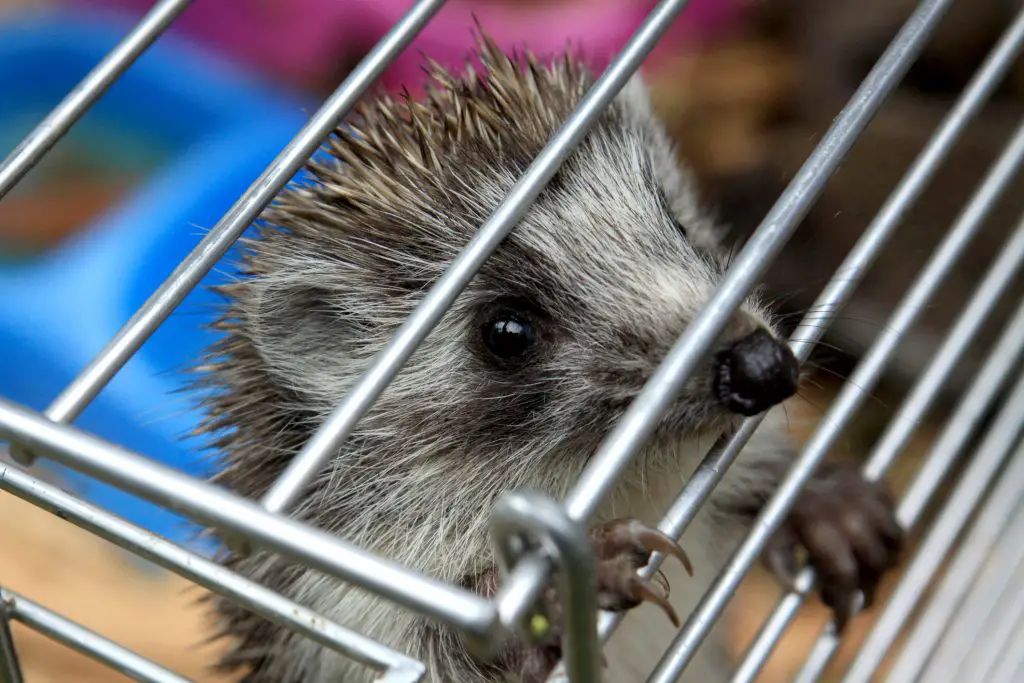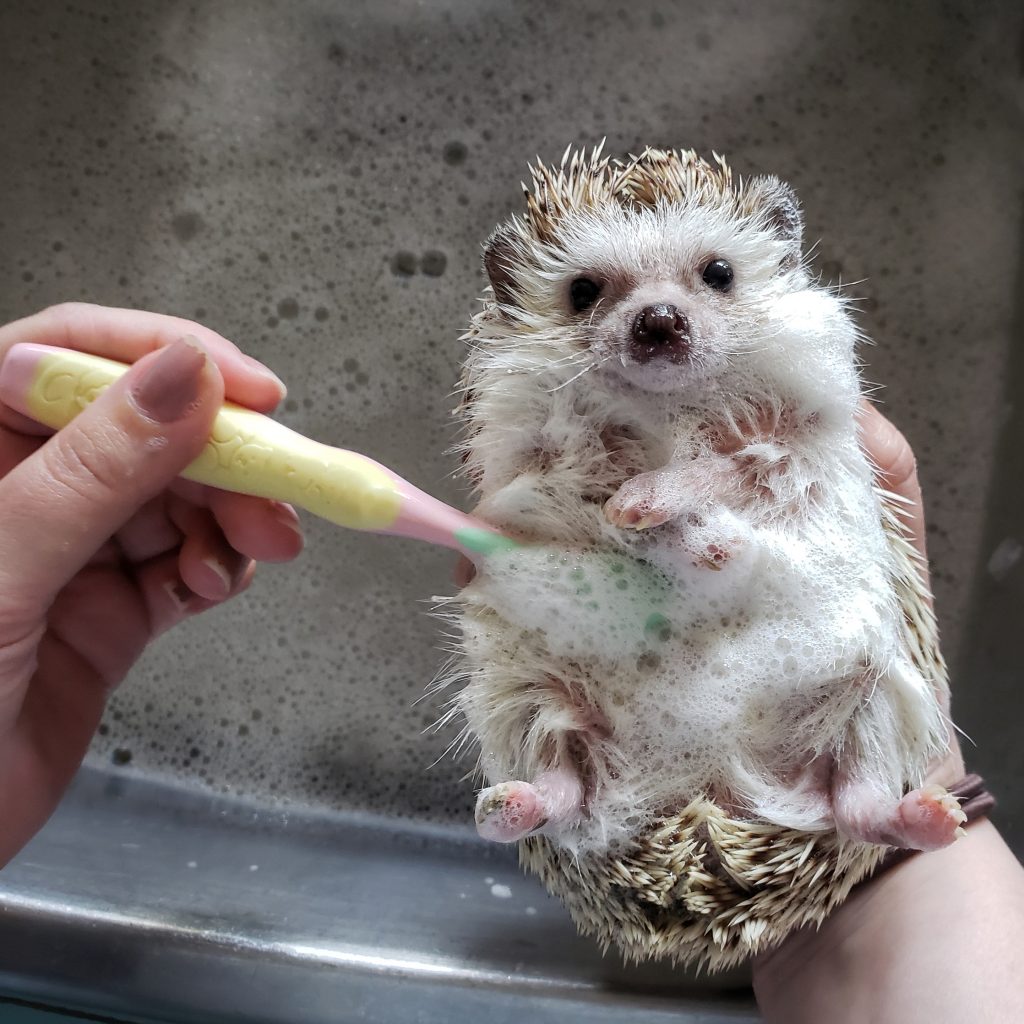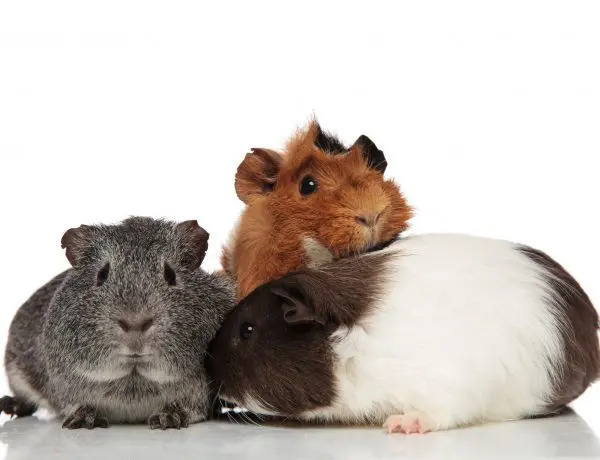Hedgehogs are pretty adorable creatures. If you live in the U.S., you’re not likely to see one in the wild, but you’ll find that it is not so rare for some people to have them as pets. If you’re thinking about bringing one home, you may have some questions about how to take care of them.
How exactly do you raise a hedgehog? This guide will explore what you need to know about raising a hedgehog as a pet: from getting the right supplies to keeping your hedgehog healthy, well-fed, and exercised.
There’s a lot that you need to learn about keeping a hedgehog as a pet before you decide to bring one home. If you look at it the same as having a cat or a dog, you will end up unhappy, as will your hedgehog. Having a hedgehog as a pet requires a certain amount of patience and responsibility for them to be happy and healthy. Still, it can be quite rewarding when done correctly. We’ll give you the information about caring for a hedgehog, so you can learn whether this spiky little friend is for you.
Table of Contents
How to Raise a Hedgehog
Before bringing home any new pet, especially one that may be unfamiliar to you, it’s essential to know what you need and what to expect.
- Supplies: Before getting a hedgehog, it’s crucial to get the necessary supplies: an enclosure, food, water, toys, and a grooming kit. If you own a hedgehog, you are aware of the amusing habits such as tubing and self-anointing.
- Know how to keep your hedgehog healthy: Be cautious of the health problems your hedgehog might face, such as infections, eye troubles, mites, and the most preventable but unbearably common, obesity. When you follow a good overall care regimen such as bathing, cleaning the hedgehog, trimming the nails, and cleaning the cage thoroughly, it should greatly minimize the risk of health concerns for your spiky little friend.
- Know how to feed your hedgehog: Proper diet is crucial for a hedgehog since the obesity issue is a real problem. It’s tempting to give your beloved pet a few extra treats. Every pet owner understands that. But it’s your job to make sure they are properly taken care of and healthy. Follow a proper diet, and all will be fine.
- Make sure they get playtime. Playing with your hedgehog is important to enhance the bond. However, remember that hedgehogs are solitary in nature and also require some space. If you respect that, it will only strengthen that bond. There are plenty of toys available for playtime to keep your pet stimulated.
- Be careful about roommates: If you get one hedgehog and are tempted to get another, note that males and females will not work out unless the goal is to breed. Two females together can coexist and sometimes prefer a cagemate, while two males will lead to aggression.
- Get accustomed to their nocturnal nature: When your pet is awake and active at night, you will need to arrange time for interaction.
First Step: Make Sure Hedgehogs Are Legal In Your State
You want a hedgehog. Great! But the real question is, are you legally allowed to have one where you live? There’s no point in buying everything for a hedgehog, only to find out it’s illegal. Fortunately, hedgehogs are legal in most states. These are a few exceptions that we were able to find:
- Pennsylvania
- Hawaii
- California
- Georgia
- Maine
If you live in these states, you might be out of luck. However, it is possible to acquire a permit in a few of these states. So if owning a hedgehog is something you are dead-set on, it may take some extra preparation and paperwork on your part, but it may still be possible.
What Do I Need To Raise A Hedgehog?
Surprisingly, there are a lot of things you need to buy for a new hedgehog, such as supplies and food – but don’t forget about the vet! All of these expenses can add up, so do as much research as possible and fit everything in your budget. With any pet, make sure you have extra funding available to be able to afford any emergencies as well as the everyday things they need to enrich their lives and keep them stimulated.
Gathering Supplies
In order to keep a hedgehog happy and healthy, it’s important to have all the necessary supplies. Ideally, get these set up in your home before purchasing the hedgehog. This will ensure your pet is ready to go once you bring them to their new home. They need to get familiar with their new environment as soon as possible.
Hedgehogs need an enclosure to feel safe. Buying a standard-sized guinea pig cage should be more than enough. You will also need proper bedding and shavings, and enough that you will be able to change them out every two weeks. However, beware of pine or cedar shavings! Don’t use them as bedding, as they are toxic to hedgehogs. If you need to use pine shavings, make sure that you look at the package and only get ones that are kiln dried! Cedar, avoid completely.
They also need a hiding area in the cage, a water bottle, food bowls, and toys. Getting a wheel might be a good idea since hedgehogs are typically athletic and like to be active. Having grooming supplies and a playpen outside the cage is also recommended. It’s essential to take the hedgehog out every now and then for socialization.
Below is a chart showing some basic suggestions while shopping for the necessary supplies for your hedgehog:
| Item | Purpose |
|---|---|
| Enclosure | Security |
| Bedding | Comfort/Odor Control |
| Hideout | Security |
| Water Bottle | Hydration |
| Food Bowl | Hunger |
| Toy-Wheel | Exercise |
| Grooming Kit | Health |
What To Look For In Essential Items

You know what items you need ahead of time now, great! But do you know what to look for in them?
Habitat Size
For the enclosure, is it big enough for a hedgehog? It’s better to buy a bigger cage because hedgehogs need space to run around and play. They like to move around a lot when they are feeling active. The minimum space required is about 24 x 24 inches, which is around four square feet, but a more active hedgehog may appreciate a little more area than this. The cage should be big enough for a wheel, an eating area, and a resting area.
Bedding Materials
For the bedding, as I mentioned above, avoid cedar or pine shavings. Cedar shavings are toxic and irritate the hedgehog’s skin, which may lead to health problems. You should also avoid dusty shavings, as that could be an irritant for your hedgehog’s skin.
Some hedgehogs love to have an extra fluffy bedding area where they can sleep the day away. Like cats, hedgehogs appreciate cozy spaces to chill out and relax. A simple small box could do, but there are plenty of other options online.
Other Important Supplies
Water bottles and food bowls are a must. They will keep your beloved hedgehog alive. Keep them small and attach the water bottle to the cage like you would a guinea pigs. While you might be out and about, leave some toys in the cage to keep your pet stimulated. Toys such as small balls, toy dump trucks, or even small mazes keep their brain thinking and help keep them from getting bored. Many people recommend putting a toilet paper roll or something around that size in the cage with your hedgehog; I wouldn’t recommend it though. Farther down in this article, I’ll go into tubes more. But for now, just know that I believe it is better to use them as toys while you’re having playtime together, and your hedgehog is being supervised.
For their nails, you can buy specialized nail clippers like this that say they are for hedgehogs – but in reality, most of them are regular nail clippers with a magnifying glass attached to them. If that helps you, great. Otherwise, stick with regular nail clippers or ones made for use on toddlers.
Hedgehog nails need to be trimmed every 2-4 weeks. If not, the nails will curl under and will require a vet visit.
Disinfectant of some kind will be necessary to kill any bacteria when you’re cleaning the cage. Getting sprays that are pet-safe like this one are good options.
Potential Health Problems of a Pet Hedgehog
Like any other pet, take your hedgehog to the veterinarian regularly for checkups. Get to know your hedgehog’s normal behavior, so you can tell if they start acting a bit off or have changes in their routine or diet. One important clue is to look at their stool regularly to make sure it’s not diarrhea.
Most hedgehog health issues can be spotted by a good veterinarian. The most common health problems hedgehogs face are:
| Mites | To tell if your hedgehog has mites, observe the quills. Are they losing any? Is your hedgehog scratching, biting, or constantly licking itself? Is it losing a lot of weight? Is it lethargic or showing any flaky skin? These are the telltale signs. Fortunately, it’s easy to treat hedgehogs for mice with a visit from the vet. |
| Obesity | A lot of pet owners are guilty of overfeeding. Hedgehogs need exercise, don’t overfeed them foods high in fat, or too many treats. It’s tempting to treat your pet, but this is so they can live a longer life. If your hedgehog can’t completely roll into a ball, there’s a problem. |
| Respiratory infection | It’s easy for a hedgehog to develop a respiratory infection. Common symptoms are nasal discharge, sneezing, and difficulty breathing. |
| Wobbly Hedgehog Syndrome (WHS) | This a neurologic issue with symptoms that include lethargy, off-balance, stopped eating, and being unable to stand. There is no diagnostic test for WHS, so it must be diagnosed by observation. |
| Eye troubles | Hedgehogs are prone to eye injuries and corneal ulcers. Their eye sockets are shallow, so a little trauma can cause them to pop out. Due to their heightened sense of hearing and smell, a blind hedgehog can be perfectly fine. |
| Gastrointestinal infections | For gastrointestinal infections, a symptom easy to spot is diarrhea. They are also prone to eye injuries and corneal ulcers |
Hedgehog Hygiene
You now know how to keep your hedgehog alive, but not yet about keeping them clean. Fortunately, hedgehogs don’t smell nearly as much as some other animals. Some hedgehog owners vouch that they are odorless. However, that doesn’t mean they don’t need baths or their nails trimmed.
Luckily, you only need to set time aside once a month to bathe your hedgehog. This will keep them happy and healthy. You only need to trim their nails every 2-4 weeks. Trimming their nails is crucial because the nails will curl under and cause problems if they get too long. It can be a tricky task, so be careful.
How to Bathe a Pet Hedgehog

Typically, you should bathe your hedgehog once a month. Setting it in the sink is perfectly fine. Once the hedgehog is in there:
- Pour some warm water on the back, but be careful to not let the water douse their face or ears.
- Drain the sink, so it doesn’t get too full. A little bit of water is more than likely going to be fun for your hedgehog, but too much and you risk drowning them!
- Mix in a drop of shampoo with the water and pour it over the hedgehog.
- Take a toothbrush and lightly brush with the spines and belly, not against. Be thorough!
- Wash their claws
- Rinse them well
- Dry them off. You may find they enjoy cuddling in the towel while you’re holding it afterward.
Trimming a Hedgehog’s Nails
Like bathing, it’s important to trim the nails often. Hold up the hedgehog in the same manner that a mother cat holds her kittens by the neck. A hedgehog’s nails are not like a cat’s claws or dog’s nails. Take extra care to make sure you don’t cut much.
Cleaning the Hedgehog’s Cage
To keep your hedgehog happy and healthy, you should clean their cage often. A hedgehog’s overall health is very dependent on its living environment. Do not put off cleaning their cage if it needs to be done. Doing so can quickly lead to it becoming an unhealthy environment for them. There are a few items that I would recommend:
- Cat litter scooper
- Bottle of disinfectant
- Bottle of clean water
- Paper towels
- Bedding or shavings
You can clean the cage by these easy steps:
- Remove the hedgehog from the cage.
- Place the hedgehog in a playpen or safe area.
- Remove all items from the cage.
- Dump or scoop out the bedding- change it every two weeks.
- Spray the base and walls with the cleaning solution.
- Wipe off the cleaning solution with paper towels.
- Spray the floor and walls with water.
- Wipe the water off.
- Refill the cage with new bedding or shavings.
- Clean any toys with hot water.
- Place all toys back.
- Put your hedgehog back in their clean cage.
The Proper Diet for Hedgehog
Hedgehogs are either omnivores or insectivores. They mainly eat creepy crawlies, which take up about 70% of their diet in the wild. Here are a few things you can feed your hedgehog to ensure a balanced diet and a happy, healthy pet.
- Mealworms- live or freeze-dried
- Waxworms– higher in fat, should be a treat for hedgehogs and not used exclusively
- Crickets- provides chitin and mental stimulation, the breed of cricket may make it easier or harder for them to eat, keep an eye out to make sure they do not have problems with the ones you chose.
- Fruits– fresh only: apples, bananas, berries, melons
- Vegetables– fresh only: tomatoes, green beans, cooked squash
- Cooked meat– canned dog or cat food, cooked chicken
- Cooked eggs– provides protein- scrambled or hard-boiled
- Pinky mice– used as a treat: live or freeze-dried
- Hedgehog kibble– 30% protein, 20% fat
How Much to Feed a Hedgehog – and When
That was a lot of information to swallow, so let’s break it down more simply. Since hedgehogs are prone to obesity, it’s important to keep tabs on how much food you feed them. You should feed them 1 or 2 tablespoons of hedgehog kibble with an additional teaspoon of fruits, vegetables, and insects every day.
Since hedgehogs are nocturnal, they will more than likely want to eat at night when they are more active. As a result, you typically will not see them eat much during the day. There are also some foods that you shouldn’t feed hedgehogs. Do not feed hedgehogs dairy products because they are lactose intolerant. They are also not capable of digesting bread.
Keep a Hedgehog Active Through Play
Hedgehogs enjoy being a bit social every now and then, so be sure to take them out of the cage and let them play every once in a while. Have a safe space, a playpen where your hedgehog can go, and run around inside the house. If you don’t have a safe space for them, buy plenty of toys to keep them stimulated.
Because hedgehogs need to play, they don’t typically go well with children. Their spines are sharp. If a child is not careful, they may be hurt or injured. Playing with a hedgehog requires being cautious and aware, which we all know children are not always prone to be.
Choosing the Right Toys for a Hedgehog

Since hedgehogs are considered athletic, even though they don’t look like it, you should have some toys for them to play with. The most commonly recommended toy for a hedgehog is a wheel for it to run on. Another is a maze that keeps their brain thinking and occupied.
Recommended toys:
Good news! If you have a cat, cat toys work, too. Sounds strange, right? When we say cat toys, we mean small balls the hedgehog can push around. Major bonus points if there is a rattler inside. The noise will stimulate the hedgehog even more than its determination to push.
Tissue boxes and any small boxes are perfectly fine. Just be sure to remove anything that might be inside that could be considered dangerous such as something small they could eat and endanger themselves with.
In addition, small stuffed animals are fun for your hedgehog. If it originally belonged to your cat, make sure to remove any catnip it might contain and wash it well first.
If you have any toy trucks around, give them a try! Like the balls, your hedgehog may like to push the truck around.
Of course, most things in your house can become a toy with proper supervision.
Should Hedgehogs Have a Companion?
The short answer is probably no. It’s critical to note that the vast majority of hedgehogs are shy and solitary in nature. It is not recommended to keep two together unless they are both females. The only time they come together in the wild is during the mating season.
If hedgehogs don’t get along, they might fight. This will lead to serious injury. Although it’s been observed that some female hedgehogs like to live with other females. If you get two, make sure they are both females. Two males will generally always lead to aggression.

Since hedgehogs are solitary in nature, it may be difficult for them to warm up to their owners. As such, give them some space to be alone. That’s just as important as it is to play with them to create a bond. Remember that hedgehogs naturally like to keep to themselves, respect that, and give them time. Talk to them every now and then. They will notice your efforts and see that you care for them.
An interesting note on companionship – hedgehogs and cats, in many cases, coexist fine. They are an interesting pair, but many pet owners of both report that they are just merely indifferent toward each other and nothing more. Sure, the cat might check out the hedgehog, but it typically doesn’t go beyond that. With the spikes, most cats know to stay away and to not mess with them. This way, injury is not a huge issue.
Your Hedgehog’s Nocturnal Nature
Please keep in mind that your hedgehog is nocturnal. This means they will sleep mostly during the day, so respect its space during that time. This makes it easier for people to care for them if they have a traditional job from 8am-5pm.
At night, plan some interactions with the hedgehog. Set some time aside to forge that bond. Since hedgehogs are solitary in nature, it will take a while for them to warm up to you. You should expect that they definitely will not come running to you, like a dog would, for quite a long while.
Remember, even if you want to play with your hedgehog, that doesn’t mean it wants to interact with you. Watch the signs. Is the hedgehog out of its hidden space and in the open? Is it deliberately running to the corners of its cage to get away from your hands? Try not to force any interaction.
Amusing Hedgehog Habits
Owning a hedgehog, like many other pets, can be quite amusing at times. Hedgehogs self-anoint and tube. If you have not heard these terms before, you may likely have seen a hedgehog video doing one of these things.
Self-Anointing
So what is self-anointing, you ask? Picture this. Your hedgehog is going about his or her day then stops suddenly. It backs up, twists its body, foams at the mouth like it has rabies, and licks the foam to douse the spine. It might catch you off guard, but it’s completely normal.
While it is debated why hedgehogs self-anoint, there are two more popular held theories. Some scientists think it’s a form of self-camouflage to cover up their scent with the new aroma in an environment. Like the spikes on its spine, self-anointing could be a self-defense mechanism. Others think they cover themselves because they like the smell, and it acts as a perfume. Some have been observed eating dog treats and self-anointing with those.
Tubing
A common favorite toy among hedgehogs is tube tunnels. Since they like ‘tubing,’ it is almost an essential item to have. I would only recommend letting them play with items like this that they can get their head stuck in when you are around. I would not recommend leaving them in their cage for them while unattended! They love to explore. While there are some of these out there that you can purchase, an empty paper towel or toilet paper roll works every bit as well!
There are plenty of videos online explaining tubing in more depth. Owners of hedgehogs buy tiny, lean tubes so their pets can stick their heads through. The hedgehogs knowingly get their heads stuck for long periods.
There are a lot of accounts of people wondering why their hedgehogs love the tubes so much. Experts think it’s because it’s the instinct for the hedgehog to look for food. Insects live in cave-like structures, and the tubes mimic that.
What Type of Hedgehog Makes a Good Pet?
There are 14 categorized hedgehogs species, but not all of them make good pets. As such, there are certain types that are recommended to take on as a pet. Below is a chart of the types of hedgehogs and the average cost you can find them for (keep in mind, your location can drastically influence the prices.)
| Type of Hedgehog | Estimated Cost |
| African pygmy hedgehog | $75-$200 |
| Egyptian long-eared hedgehog | $80-$300 |
| Indian long-eared hedgehog | $70-$250 |
Reproduction and Lifespan of a Pet Hedgehog
Everyone wants their pets to live for a long time. For the three species listed above, these hedgehogs can live to be 5-years-old. This isn’t as long as the average pet. For example, guinea pigs live for about 5-8 years. Hedgehogs are a considerable time commitment, but in a different way than a dog or cat.
Male and female hedgehogs have several different partners during the mating season. It’s considered an invasive procedure to spay or neuter a hedgehog. As such, don’t own a male and female if you’re not looking to raise baby hedgehogs.
How Big Will a Pet Hedgehog Get?
For the three most common species to own, it’s important to know more about them before deciding to get one. You know also know what to expect in how big the hedgehogs will become. Here is a little more about them:
| Type of Hedgehog | Natural Habitat | Length | Weight |
|---|---|---|---|
| African pygmy hedgehog | Africa-Senegal, Somalia, Tanzania | 6.3 in | 16 oz |
| Egyptian long-eared hedgehog | Middle East- Central Asia, Egypt, Libya | 8.3 in | 12 oz |
| Indian long-eared hedgehog | India, Pakistan | 6.4 in | 4.5 oz |
The conservation of these different species of hedgehogs is at the ‘least concern’ level. Hedgehogs have been thriving for a long time now, with species are from all over the globe. They are about the same length but may vary drastically in weight. Not to mention, they are all nocturnal, so it’s important to respect that. They are tiny, adorable creatures.
Comparing the 3 Common Types of Hedgehogs
The African Pygmy hedgehog is the most commonly owned type in the United States. It’s also known as the four-toed hedgehog due to the number of toes on its hind feet. It is the most domesticated and smallest species of hedgehog. It’s a hybrid of 2 species: the North African or Algerian hedgehog.
The Egyptian Long-Eared hedgehog is considered one of the smallest Middle Eastern hedgehogs. Their senses are a little more acute than other species. Obviously, it also has longer ears than the African Pygmy. It has light brown-banded quills with white tips. It hasn’t been domesticated for as long as the African Pygmy, so it’s more prone to aggressive behaviors.
The Indian Long-Eared hedgehog tends to get water from its diet in the wild, so it might drink less water. It also has large ears, eyes, and whiskers. Due to this, their senses are heightened. It experiences more significant heat than the other 2 species. For the mating process, males’ dance’ around the females for several days before mating. It thrives in the desert, so it prefers to burrow.
Where to Adopt a Hedgehog
It’s essential to make sure you buy a hedgehog that isn’t already sick. Unfortunately, a lot of pet store hedgehogs could be ill. The trick is to check their eyes. If they have bright eyes and are displaying signs of curiosity and energy, then it’s a healthy hedgehog. If it seems lethargic, then it might be ill.
Another option is to talk to a hedgehog breeder. Good breeders make sure the genetics in hedgehogs are good, and their hedgehogs are healthy. There are plenty of lists online of hedgehog breeders in every state. They breed the carefully selected mates to ensure your hedgehog can live a long, fulfilling life.
Now You’re Ready for Your New Friend
With adopting any new animal, it’s wise to buy all the supplies beforehand. So when you and your hedgehog get home, it can get familiar with its surroundings quickly. Have the food prepared, the toys out, get ready to have some fun, and look forward to a great 5-7 years with your beloved pet!




